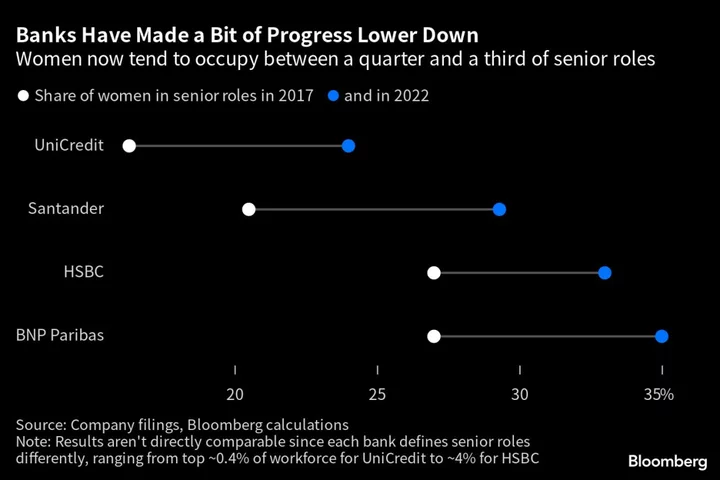When Christiana Riley left Deutsche Bank AG last month, the board member’s exit exposed an embarrassing problem: the lender’s failure to meet its own gender diversity target.
After Riley’s departure, only one out of the nine seats on the German giant’s management board is occupied by a woman, meaning the bank has fallen short of its professed goal of having at least two female executives at the top. Supervisory Board Chairman Alexander Wynaendts vowed to do “everything” in his power to change that “over time,” but ended up giving Riley’s job to a man instead.
The issue of gender diversity has become more acute for Deutsche Bank, with its investment arm DWS Group recently losing two senior women — Chief Financial Officer Claire Peel and Americas ETF head Fiona Bassett. Instead of adding more female leaders, Deutsche Bank is currently struggling to retain the few it has in its ranks. A further blow is the unexpected departure of Asia private banking head Jin Yee Young for UBS Group AG.
The challenges faced by the German lender in attracting and retaining top female talent are emblematic of Europe’s financial services industry, where it’s still rare to see women at the highest management echelons. Regulators see this as a big governance challenge and the European Central Bank has stepped up pressure on lenders to close the diversity gap.
“Increasing gender diversity on banks’ executive teams is going to remain a challenge,” said Charlotte Carvin, a senior analyst at credit rating firm DBRS Morningstar who compiles periodic reports on the subject. “That also means it’s something where banks that prioritize the issue can make a real difference.”
Despite the push, just three of the 30 biggest European banks have female chief executive officers, namely NatWest Group Plc’s Alison Rose, DNB Bank ASA’s Kjerstin Braathen and Svenska Handelsbanken AB’s Carina Akerstrom.
Read More: Here Is One Way to Close the Gender Pay Gap: Andreea Papuc
Deutsche Bank’s board is “committed to establishing and developing a career plan for potential female successors in each case,” a spokeswoman for the lender said by email. The bank has programs in place “to enable high-potential women to take on more extensive tasks in top positions in the company,” she said.
Men account for 92% of all top wider leadership roles — defined as board chair and CEO — a Bloomberg review of Europe’s 30 largest banks shows. The same applies across most industries, with women holding just 8% of board chairs and CEO posts at largest listed companies in the European Union, according to the European Institute for Gender Equality.
Little has happened over the past few years to change that. In fact, no female CEO has been named since Braathen, Rose and Akerstrom took on their current roles in 2019. Including them, banks in the region have appointed 23 new CEOs since then, data reviewed by Bloomberg shows.
In a strongly worded statement last month, the ECB said it “will use the supervisory tools already available” to push banks toward more gender diversity, adding its actions recently prompted an unidentified bank to improve diversity on its board.
“Gender-balanced management encourages a broader range of views, opinions, experiences, perceptions, values and backgrounds,” the ECB said. “This is crucial for avoiding group think or herd mentalities, and may also be beneficial for the soundness of the bank.”
Paying too little attention to the issue for years, if not decades, means the ranks below the top are still overwhelmingly staffed by men, even though most banks’ total workforce includes about as many or even more women than men.
The balance gets increasingly skewed further up the career ladder, which means that the talent pool that banks draw from for promotions higher up tends to be skewed as well.
To be sure, most European banks have stepped up efforts to increase diversity. They’ve set targets for female representation among top leadership and lower management, and many have added gender diversity goals to the metrics they use to assess management performance.
That seems to be paying off at some banks, the data shows. For example, the share of women in senior management positions at BNP Paribas SA — a group comprising roughly 2% of the top roles — has risen 8 percentage points over the past five years to 35%, and the aim is to hit 40% by 2025.
But, the French bank’s highest executive body, which has five members and is known as general management, is still all men, and its chair is male too.

